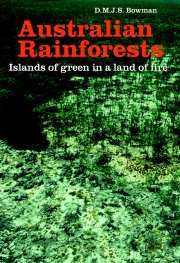Book contents
- Frontmatter
- Contents
- Preface
- 1 Introduction
- 2 What is Australian rainforest?
- 3 The sclerophyll problem
- 4 The edaphic theory I. The control of rainforest by soil phosphorus
- 5 The edaphic theory II. Soil types, drainage, and fertility
- 6 The climate theory I. Water stress
- 7 The climate theory II. Light and temperature
- 8 The fire theory I. Field evidence
- 9 The fire theory II. Fire, nutrient cycling, and topography
- 10 The fire theory III. Fire frequency, succession, and ecological drift
- 11 The fire theory IV. Aboriginal landscape burning
- 12 The fire theory V. Aridity and the evolution of flammable forests
- 13 The fire theory VI. Fire management and rainforest conservation
- 14 Summary
- References
- Index
3 - The sclerophyll problem
Published online by Cambridge University Press: 23 November 2009
- Frontmatter
- Contents
- Preface
- 1 Introduction
- 2 What is Australian rainforest?
- 3 The sclerophyll problem
- 4 The edaphic theory I. The control of rainforest by soil phosphorus
- 5 The edaphic theory II. Soil types, drainage, and fertility
- 6 The climate theory I. Water stress
- 7 The climate theory II. Light and temperature
- 8 The fire theory I. Field evidence
- 9 The fire theory II. Fire, nutrient cycling, and topography
- 10 The fire theory III. Fire frequency, succession, and ecological drift
- 11 The fire theory IV. Aboriginal landscape burning
- 12 The fire theory V. Aridity and the evolution of flammable forests
- 13 The fire theory VI. Fire management and rainforest conservation
- 14 Summary
- References
- Index
Summary
In his essay on Australian phytography, Hooker (1860) demonstrated that the Australian vascular flora was not taxonomically unique. Instead, he concluded that the ‘peculiarities of the Flora, great though they be, are found to be more apparent than real’. However, Hooker felt that many components of the Australian flora had a ‘very peculiar habit or physiognomy, giving in some cases a character to the forest scenery (as Eucalypti, Acaciae, Proteaceae, Casuarinae, Coniferae)’ with some plants having ‘an anomalous or grotesque appearance’ (Figure 3.1). The idea that the dominant Australian vegetation has a peculiar physiognomy including a particular prevalence of sclerophylly is central to a number of definitions used to distinguish rainforest from characteristically Australian vegetation (Francis 1951; Beadle and Costin 1952; Webb 1959, 1968, 1978). Webb differentiated non-rainforest vegetation from rainforest on the basis of sclerophylly. Confusingly, he conceded that rainforest trees species could have leaves that are anatomically sclerophyllous (Figure 3.2). He attempted to explain this contradiction by arguing that ‘sclerophylly has no general anatomical justification when used in its ecological sense’ although he suggested that ‘sclerophyll’ non-rainforest species might be physiologically and chemically distinct from rainforest plants that are also anatomically sclerophyllous. Other workers have argued that sclerophylly is essentially a physiological condition that enables non-rainforest plants to grow on infertile soils (Loveless 1961; Beadle 1966; Johnson and Briggs 1981). It is remarkable that despite the fact that there is no consensus as to the meaning of the term ‘sclerophylly’ it has become a central concept in Australian vegetation science.
Information
- Type
- Chapter
- Information
- Australian RainforestsIslands of Green in a Land of Fire, pp. 48 - 67Publisher: Cambridge University PressPrint publication year: 2000
